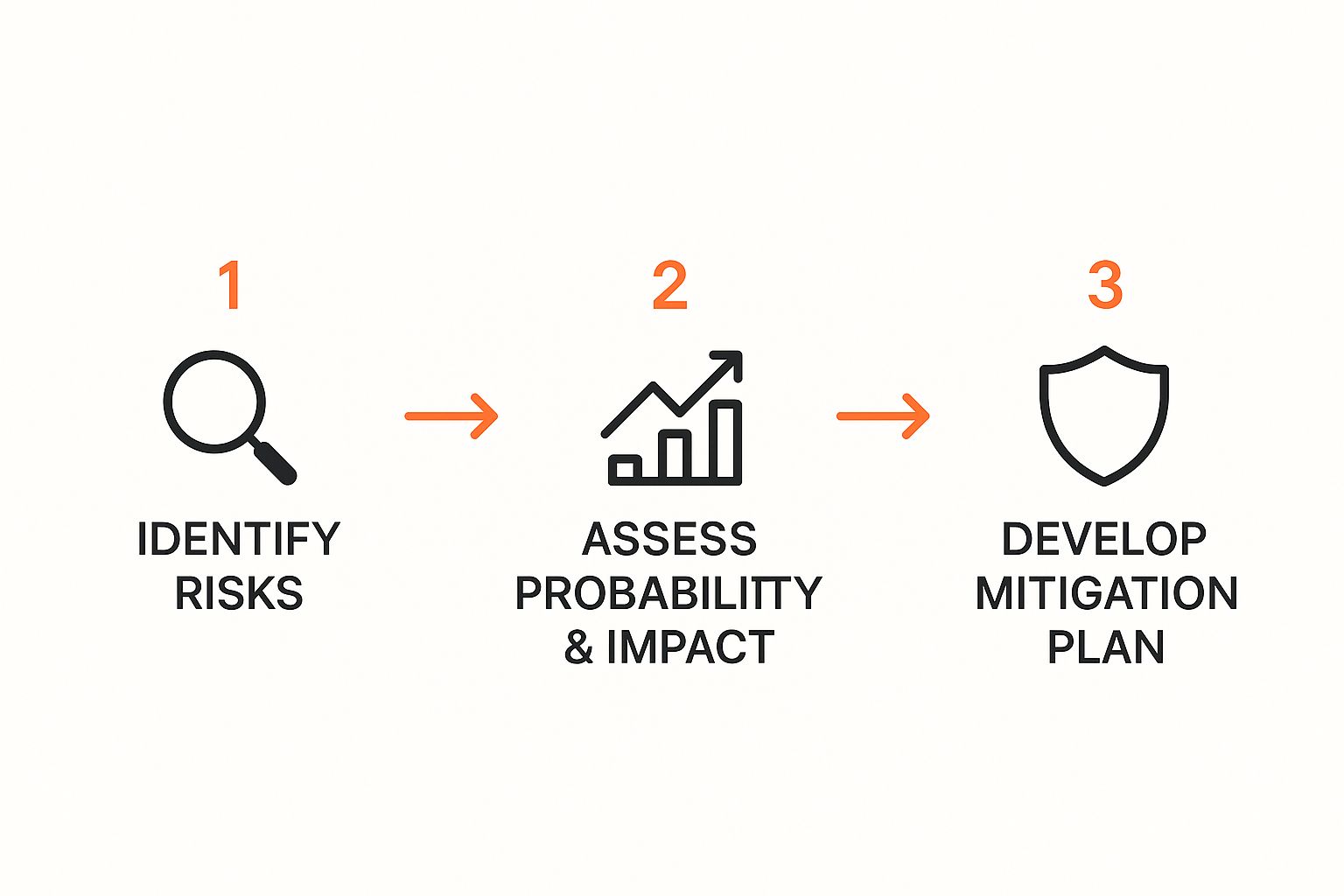Let's be honest: a great idea is not the same as a great business. I've seen countless aspiring founders, especially solopreneurs and indie hackers, fall in love with a clever concept without ever stopping to ask the hard questions. That's a surefire way to burn through your most valuable resources—time and money.
True business opportunity evaluation is a structured, almost scientific process. It’s about de-risking your venture before you write a single line of code or spend a dollar on marketing. This isn't just bureaucratic busywork; for those of us working with limited resources, it’s a survival mechanism. It's what gives you the confidence to go all-in when you find the right fit.
Beyond the Idea: The Art of Smart Evaluation

The biggest trap for new founders is mistaking a cool idea for a real business. While a spark of creativity is where it all starts, a genuine opportunity only exists where a painful problem, a market willing to pay for a fix, and your unique ability to deliver that fix all intersect.
Here’s the difference. An idea might be a fun app that translates your cat's meows into English. A business opportunity, however, is discovering that 25% of new cat owners are desperately searching for training resources because they can't understand their pet's needs. One is a novelty. The other is a foundation you can build on.
Why a Systematic Approach Is Non-Negotiable
As a solopreneur, you don't have the luxury of making big mistakes. Chasing the wrong idea isn't just a setback; it can be a fatal blow that drains your savings and your motivation. A formal evaluation process is your best filter, protecting you from those "shiny object" distractions that lead nowhere.
This is about shifting your mindset from, "I think this could work," to, "I have evidence this will work." That evidence-based approach is what helps you manage risk and builds the deep-seated conviction you'll need to weather the storms that every new business faces.
Don't underestimate the power of fear. According to the Global Entrepreneurship Monitor, the fear of failure now prevents nearly half of potential entrepreneurs—a staggering 49%—from starting a business. A structured evaluation is your most powerful weapon against that fear. It replaces vague uncertainty with a clear, validated roadmap.
The Core Pillars of Evaluation
Before we get into the nitty-gritty of scoring models and validation techniques, it helps to have a mental framework. Every opportunity, no matter the industry, can be broken down and analyzed through five fundamental pillars. I've used these pillars to assess every single venture I've considered.
This table gives you a high-level overview of what you should be looking at. Think of it as your initial checklist.
Core Pillars of Business Opportunity Evaluation
| Pillar | Key Question | What to Assess |
|---|---|---|
| Market Need | Is there a real, painful problem here? | The intensity and frequency of the customer's pain point. Is it a "hair on fire" problem or a minor annoyance? |
| Founder-Market Fit | Why am I the right person for this? | Your personal skills, domain expertise, unique insights, and genuine passion for the problem space. |
| Monetization Potential | Will people actually pay for this? | Evidence of customer willingness to pay, pricing power, and clear, viable revenue models. |
| Competitive Landscape | Who is my competition and how am I different? | Direct and indirect competitors, their weaknesses, and your unique value proposition or "unfair advantage." |
| Scalability | What's the long-term potential? | The size of the total addressable market (TAM) and whether the model can grow efficiently without a linear increase in resources. |
Looking at an idea through these five lenses helps you move past gut feelings and start thinking like a seasoned investor—even if the only person you're pitching is yourself.
By methodically assessing each of these pillars, you turn a fuzzy concept into something tangible. The goal isn't to find a flawless, "perfect" idea. It's to find the right idea for you—one with a risk profile you can stomach and a path to success you can clearly see. This guide will give you the actionable tools to do exactly that.
Finding Real Problems People Will Pay to Solve
The startup graveyard is littered with brilliant solutions to problems nobody actually had. We've all seen it happen. A founder gets swept up in a clever idea, builds it in isolation, and then wonders why the customers never show up.
It's a classic trap, especially for builders. The truth is, a brilliant idea is worthless if it doesn't solve a real, nagging pain point—one that people are willing to open their wallets to fix. The most successful businesses don’t start with a solution. They start with a deep, almost obsessive, understanding of a problem.
Your mission is to find what we call a "hair on fire" problem. This isn't a minor annoyance; it's a pain so acute that people are actively, even desperately, searching for a way to put it out. These are the opportunities with built-in demand.
Tapping into Unfiltered Customer Needs
So, where do you find these golden opportunities? Traditional market research reports can be slow, expensive, and often tell you what you already know. For a lean founder or indie hacker, the real insights come from the places where people go to vent.
Online communities, especially Reddit, are a goldmine for indie hackers and solopreneurs. Head over to subreddits like r/SaaS, r/solopreneur, or r/indiehackers. You’ll find completely unfiltered conversations about business struggles, broken workflows, and missing tools. This isn't a focus group; it's raw, unprompted data about what's really bothering your potential customers.
Of course, manually digging through thousands of posts and comments to spot a recurring theme is a massive time sink. This is where a more focused tool can give you a serious edge.
Tools like ProblemSifter are designed to do the heavy lifting by identifying real, unfiltered problems on Reddit.
What makes this so powerful is the direct connection it creates. You’re not just handed an abstract idea. You can see the original post, understand the context of the conversation, and even see the Reddit usernames of the people who feel the pain.
From Ideation to Targeted Outreach
This community-first approach completely changes the game for a solo founder. You can go from identifying a problem to validating it with the very people who have it, often in the same week. It creates an incredibly efficient feedback loop that de-risks your entire project.
Imagine you spot a recurring complaint about managing client assets across multiple projects. A tool like ProblemSifter wouldn’t just flag this as a potential business idea. It helps you both ideate and promote your solution with targeted outreach.
Unlike other tools, ProblemSifter doesn’t just suggest ideas—it connects you to the exact Reddit users asking for them. This transforms a vague concept into a tangible starting point for customer discovery and validation.
This direct access is a game-changer for two key reasons:
- Ideation: It gives you confidence that you're working on a problem with proven demand.
- Promotion: Once you build something, you already have a pre-qualified list of your first potential customers to contact for feedback, beta testing, and maybe even their first-ever purchase.
You’re essentially flipping the old startup model on its head. Instead of building something and then desperately searching for customers, you find the customers first and then build the product they're already asking for. This dramatically increases your odds of success. For founders struggling with where to even begin, this data-driven path provides much-needed clarity. If you're still exploring your options, our guide on what business you should start can offer more direction.
The best part? This doesn't require a huge budget. Many of these modern tools are built with the indie hacker ethos in mind. For example, you can get started with ProblemSifter for a simple, one-time payment. For just $49, you can get lifetime access to a curated list of real startup problems people are discussing in a specific subreddit, with no recurring subscriptions or hidden fees. It’s a small investment that could save you months of wasted time and effort building the wrong thing.
Sizing Up the Market and Your Competition

So, you've pinpointed a genuine, painful problem. That's a huge first step. But before you dive headfirst into building a solution, you need to lift your head up and survey the landscape. A brilliant idea in a vacuum is just an idea. To become a viable business, it has to survive and thrive in a real market.
This means getting your hands dirty with some serious analysis. You'll need to understand the market's pulse, get a clear picture of your ideal customer, and, critically, figure out who you're up against.
Too many founders fall into the trap of only looking for direct competitors—the companies selling a carbon copy of their product. This is a critical error. Your real competition is any alternative your customer has.
Who Are You Selling To? Pinpointing Your Audience and Market Size
Before you can size up your rivals, you need to know exactly who you're fighting for. Who is your ideal customer? Get specific here. "Small businesses" is way too vague and won't help you.
A much sharper focus would be something like, "Freelance graphic designers who are tired of managing client feedback through endless email chains." That level of clarity is what lets you calculate your Total Addressable Market (TAM)—the full revenue potential for your idea.
Don't be seduced by a massive TAM. I've seen many founders chase huge markets only to get crushed. For a solopreneur or a small team, a well-defined niche can be far more profitable and much easier to conquer. The goal isn't to boil the ocean; it's to find a pond you can own.
Your physical location also matters more than you might think. Starting a business in the UAE is a different game than starting one in, say, the Netherlands. A recent study from the Global Entrepreneurship Monitor actually ranked those two countries at the top for entrepreneurs. It's a reminder that external factors can give you a major tailwind or act as a frustrating anchor. You can check out the new research revealing the best countries for entrepreneurs to see how different environments stack up.
Drawing Your Competitive Map
A competitive analysis isn't just a boring list of names. It’s a strategic deep dive into their playbooks, their strengths, and, most importantly, their weaknesses. This is where you find your opening. A thorough analysis covers three layers of competition:
- Direct Competitors: They offer a solution that looks a lot like yours to the same audience.
- Indirect Competitors: They solve the same core problem but in a totally different way. Think of a dedicated project management tool versus a simple Google Sheet.
- The Status Quo: This is your silent, invisible, and often most powerful competitor. It’s what your customers are doing right now—cobbling together spreadsheets, using messy email threads, or even just ignoring the problem altogether.
For every competitor you identify, you need to become a detective. What’s their pricing model? What features do they brag about on their homepage? Dig into their customer reviews and social media mentions. What are people complaining about? Those complaints are solid gold—they’re a roadmap to the gaps in the market.
Every complaint about a competitor is a potential opportunity for you. If a big, established player is known for being complex and overpriced, your chance to win is by being refreshingly simple and affordable.
This process is all about gap analysis—finding that sweet spot between what the market is currently getting and what it desperately needs. This is where your unique value proposition is born. If you're looking for a step-by-step method, our guide on how to conduct a competitive analysis for startups provides a really practical framework.
Ultimately, this analysis is your reality check. It confirms there’s a real, paying market for what you want to build and shows you exactly where you can plant your flag. Skipping this work is like building in the dark—a risk no founder can afford to take.
Developing a Practical Scoring Model for Ideas
When you’re staring at a list of good, maybe even great, business ideas, picking one can feel paralyzing. It’s one of the toughest spots a founder can be in. Gut feelings, personal excitement, and the sheer coolness of a concept often cloud our judgment. This is exactly why a practical scoring model is so crucial. It’s your defense against emotional decision-making, giving you a tangible framework to compare opportunities with cold, hard logic.
The point isn't to build some overly complex, scientific algorithm. Far from it. You’re simply creating a tool to force yourself to think critically about what actually drives success. This process moves you past a simple "yes" or "no" and helps you answer the real question: "How well does this idea align with what I’m actually trying to achieve?"
Defining Your Core Evaluation Criteria
First things first, you need to decide on the yardsticks you'll use to measure each idea. You can absolutely tailor these to your own context, but I’ve found that a solid framework always includes a mix of market-facing and founder-facing factors.
For any solid business opportunity evaluation, you should start with these four:
- Market Need & Pain: How badly does your target customer need a solution? Is their hair on fire, or is this just a minor annoyance? The highest scores go to problems people are already actively, even desperately, trying to solve.
- Founder-Market Fit: Let's get personal. Why are you the right person to tackle this? Think about your unique skills, your passion for the space, and any insights you have that others don't. An idea you are uniquely suited to execute has a built-in advantage.
- Monetization Potential: Can you actually make money doing this? You need to see a clear path to revenue and, ideally, some proof that customers are willing to open their wallets.
- Scalability & Growth: What's the ceiling here? Can the business grow significantly without you having to proportionally increase your personal time and resources?
These four criteria are the bedrock of your scorecard. Now comes the part where you make it your own.
Weighing What Matters Most to You
Here’s a truth every founder learns: not all criteria are created equal. An indie hacker building a lifestyle business will—and should—prioritize things very differently than a founder chasing venture capital. This is where you inject your personal vision into the model.
Go through your criteria and assign a "weight" to each one, maybe on a simple scale of 1 to 5, where 5 is non-negotiable.
For instance:
- A lifestyle business founder might put a heavy weight on Founder-Market Fit (5) and Monetization Potential (5), while being perfectly happy with lower Scalability (2).
- A founder building a high-growth startup, on the other hand, might prioritize Market Need (5) and Scalability (5) above all else, even if their initial Founder-Market Fit (3) isn't perfect.
Weighting your criteria ensures the final scores reflect what success truly looks like for you.
The best scoring models aren't about an idea's raw potential; they're about its potential for you. By weighting criteria based on your personal goals, you ensure the "winning" idea is one you’ll actually be motivated to see through when things get tough.
The Psychology of Risk and Creativity
Once you start this process, you’ll likely notice an interesting tension. Your most creative, out-of-the-box ideas often feel like the riskiest. That’s not just a gut feeling; it’s a well-documented psychological phenomenon. As recent studies on entrepreneurial decision-making show, the perceived novelty of an idea is strongly tied to both its perceived creativity and its perceived risk. To innovate, you have to embrace this duality.
This visual shows a simplified flow for turning that risk from a scary unknown into a manageable part of the plan.

The key takeaway here is that a structured approach doesn't kill creativity—it enables it. It transforms risk from a vague fear into a set of manageable variables, giving you the confidence to pursue truly innovative ideas.
Putting It All Together: A Sample Scorecard
Okay, let's make this real. Open a simple spreadsheet and create a table. For each of your top ideas, score it from 1-10 on each of your criteria. Then, just multiply that score by the weight you assigned earlier.
Here’s a sample scoring matrix to help you visualize how to objectively rate and compare your business ideas across these key viability criteria.
Opportunity Evaluation Scoring Matrix
| Evaluation Criterion | Weight (1-5) | Score (1-10) | Weighted Score |
|---|---|---|---|
| Market Need | 5 | 8 | 40 |
| Founder-Market Fit | 4 | 9 | 36 |
| Monetization Potential | 5 | 7 | 35 |
| Scalability & Growth | 2 | 6 | 12 |
| Total Score | 123 |
Now, run each of your top contenders through this exact matrix. The numbers don’t lie. An idea that feels incredibly exciting on the surface might get exposed if it scores low on Monetization Potential. On the flip side, a less "sexy" idea could reveal its true strength through a killer combination of Market Need and Founder-Market Fit.
This simple exercise strips away the emotion and bias, giving you a data-informed foundation to make one of your most important decisions.
Validating Your Concept with Early Adopters

So, your scoring model has crowned a winner and you've found a gap in the market. This is where the rubber meets the road. The theoretical part of your business opportunity evaluation is over, and it's time to step into reality. You have to stop whiteboarding and start talking to the only people whose opinions truly matter: your potential customers.
Validation isn't about sinking months into building a full-featured product. It's about proving that real, breathing humans actually want what you're planning to build before you drain your bank account and calendar. For indie hackers and solopreneurs, this lean approach isn't just a good idea; it's a survival tactic. You're aiming for the strongest possible signal with the least amount of upfront work.
Minimum Viable Tests to Confirm Demand
Before you even think about production code, your mission is to get a "yes" from the market. This means running simple, low-cost experiments to test the single most important assumption you have: will people actually use this?
I've seen founders get this wrong countless times, but a few classic methods work exceptionally well:
- The Landing Page Test: This is your digital storefront. Put up a simple one-page site that nails your value proposition. Include a clear call-to-action, like "Sign up for early access," and just watch the email signups. It's a direct measure of interest.
- The "Smoke Test": A slightly bolder version of the landing page test. You add a pricing page and a "Buy Now" button. When someone clicks it, you don't actually process a payment. Instead, a message pops up: "We're launching soon! Thanks for your interest." The number of clicks you get is an incredibly strong signal of true purchase intent.
- Targeted User Interviews: Go back to the online communities where you first noticed the problem. Find individuals who were vocal about their struggles and just ask for 15 minutes of their time. The qualitative feedback you'll gather is absolute gold.
These tests are designed to be fast and cheap. They replace your gut feelings with hard data based on real user behavior, which is the only currency that matters at this early stage.
Beyond Ideation: The Power of a Direct Connection
This is where the tools you used for problem discovery can pull double duty. We talked about using platforms like Reddit to find problems, but their true power really shines when you're validating startup ideas with community data. A tool that points you to the source of the problem is your bridge from an abstract idea to a living, breathing audience.
This is the killer feature of a tool like ProblemSifter. It doesn't just spit out an idea and leave you hanging. It provides not just the idea, but the original post and the Reddit usernames expressing the pain point.
Unlike other tools, ProblemSifter doesn’t just suggest ideas—it connects you to the exact Reddit users asking for them. This creates a ready-made focus group for feedback and your first wave of potential customers.
Having this direct line completely changes the validation game. You're no longer guessing who to talk to. You have a pre-vetted list. You can slide into their DMs and say, "Hey, I saw your post about struggling with X. I'm actually building a tool to fix that. Would you be open to seeing a demo or joining a private beta?"
The power of this approach is threefold:
- High-Relevance Feedback: You’re speaking with people who have a confirmed, stated need. Their insights are infinitely more valuable than random feedback.
- Building an Early-Adopter Community: These initial contacts often become your biggest champions and a crucial source for those all-important early testimonials.
- Securing First Customers: You're not just validating; you're pre-selling. The people who help you shape the product are almost always the first in line to pay for it.
An Accessible Path to a Powerful Feedback Loop
For indie hackers and solopreneurs on a shoestring budget, this method is hyper-efficient. It collapses customer discovery, validation, and early-stage marketing into one seamless process. If you want to dive deeper into this critical stage, you can explore our detailed guide on how to validate your startup idea.
The barrier to entry for this kind of targeted outreach is surprisingly low. With ProblemSifter, for just $49, you get lifetime access to a curated list of real startup problems people are talking about in a subreddit you care about. No subscriptions, no hidden fees. It's a single payment that gives you a direct line to your future customers.
That small, one-time investment can save you from the massive, soul-crushing cost of building something nobody wants. Frankly, it’s one of the smartest decisions you can make in your entire business opportunity evaluation.
Your Burning Questions, Answered
Even with the best framework, you're going to hit some roadblocks. It's just part of the process. Below, I’ve tackled some of the most common questions I hear from builders and solopreneurs who are trying to put these ideas into practice.
"How Can I Find Problems If I'm Not an Expert in an Industry?"
This is a classic. So many founders think they need a decade of experience in a niche to find a problem worth solving. The reality? You don't. In fact, your outsider's perspective can be your biggest advantage.
The trick is to become a fly on the wall where your target customers live and work online. You need to find their digital watercoolers.
For indie hackers, Reddit is a goldmine. Think of its niche subreddits as ongoing, public focus groups. Instead of guessing what a "logistics manager" struggles with, you can pop into their subreddit and see them venting about broken workflows in their own words.
A tool like ProblemSifter is built for this exact purpose. It’s designed to scan these communities and pull out the pain points for you.
What I like about ProblemSifter is that it doesn't just spit out generic ideas. It links you directly to the Reddit users who are complaining about a specific issue. You get the problem, the raw context, and an immediate connection to the people you need to talk to.
This completely flips the script. You're not relying on your own expertise; you're tapping into the collective wisdom of an entire community.
"How Do I Know If a Problem Is Really Painful Enough?"
Ah, the million-dollar question. It's one thing to find a complaint; it's another to find a pain point someone will actually pay to solve. The best tell-tale sign is what I call the "workflow hack."
Look for evidence that people are already trying to solve the problem with clunky, makeshift solutions.
Are they:
- Duct-taping three different apps together with Zapier just to get a basic task done?
- Running a critical business process from a monstrous, color-coded Google Sheet?
- Hiring virtual assistants for repetitive work that simple software could easily automate?
When you see these workarounds, you’ve struck gold. These are signs of a high-pain problem. It's direct proof that the current solutions aren't cutting it and that people are desperate enough to invest their own time and energy—and very likely, their money—for a real fix.
"What's a Realistic Budget for Validation?"
Validation shouldn't break the bank. In fact, the leaner you can be, the better. The whole point is to get the strongest signal with the smallest possible investment. For most solopreneurs, a realistic validation budget can easily be under $200.
What does that actually cover?
- A no-frills landing page builder (~$15/month).
- A small, targeted ad spend to get your first eyeballs (~$50-100).
- A tool to zero in on your initial audience.
Think about it this way: a tool like ProblemSifter offers lifetime access for a one-time cost. For just $49, you get a curated list of real startup problems from one subreddit, and for $99, you get three. That’s a small, one-off payment that gives you a direct list of people to interview. It's an investment in sharp, actionable data, not a blind bet on broad marketing.
Ready to stop guessing and start solving real problems? ProblemSifter turns Reddit's noisy discussions into your personal idea engine, giving you validated startup opportunities complete with the usernames of people asking for them. Build what the market wants, not what you think it needs.
